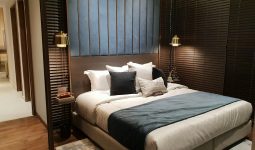Roofing shapes can vary depending on the kind of roof you have, which may be hard to figure out at first when you’re still new to the process.
If you plan on installing your roof or are looking to replace your existing one, it’s good to know about all the different types of roofing shapes and their benefits.
This will help you decide when choosing a roofing material and style.
Let’s examine the most common types of roofing shapes and how they differ from each other.
Different Types of Roofing Shapes
Gambrel
A gambrel roof is a type of roof that has two slopes on each side. The upper slope is usually steeper than the lower slope.
This roof is often used on barns and other buildings where extra space is needed.
The gambrel roof also sheds snow and ice more quickly than other roofing shapes and provides an increased volume for storage.
High-pitched
As its name suggests, a high-pitched roof features a very steep slope. They are often seen in homes or commercial structures that require higher ceilings.
A high-pitched roof does not provide any benefits related to weather or use compared with other roofing shapes.
Still, it can help increase space within the structure because it leaves room below for larger rooms or storage areas.
Wedge
Two sloping planes that meet at an apex or peak create a wedge-shaped roof. The angle of the slope is usually around 60 degrees.
This type of roof is popular because it is extreme and can resist high winds. It is also good at shedding snow and rain.
However, it can be more challenging to construct than other roofing shapes. This type of roof uses wood shingles, metal panels, concrete tiles, clay tiles, and asphalt shingles.
These are all excellent choices because they provide a durable surface that will last a long time.
Gable
A gable roof is the most popular type of roof for homes. It is also one of the simplest types of roofing shapes to build.
A gable roof has two sloping sides that form a triangular shape at a ridge. The gable roof is versatile and can be used in various home styles.
The roof is typically on either side of the building’s front door or centered on its facade.
Gables are generally easier to build than other types of roofing because they don’t involve complicated roofline shaping (like hips).
One benefit of a gable roof is that it is very good at shedding water and snow. Another advantage is that it provides extra space in the attic for storage or additional rooms.
However, there are also disadvantages. Gable roofs do not provide much protection from high winds and hail, but this disadvantage can be overcome by installing a windbreak near the roof’s edge.
Hip
A hip roof is one in which all sides slope downwards to the walls, usually with a relatively gentle slope.
Hip roofs are one of the most popular choices for residential homes because they provide increased protection against weather elements like wind and rain and are relatively easy to construct.
For these reasons, as well as their aesthetic appeal, hip roofs are popular for homeowners looking to add curb appeal.
Hip roofs are one of the most popular choices for residential homes because they offer several benefits. One benefit is that they are excellent at shedding water and snow since all the sides slope downwards.
This can help to prevent leaks and damage during bad weather. Another benefit is that hip roofs are solid and stable, making them ideal for homes in areas with high winds or seismic activity.
Modified Hip
A modified hip roof is a hip roof with two dormers, each with its own gable. This type of roof is popular in Cape Cod-style homes.
The extra space created by the dormers allows for more headroom and storage.
A modified hip roof is also more structurally sound than a standard hip roof, making it a good choice for homes with high winds or heavy snowfall.
One benefit of a modified hip roof is that it allows for more headroom in the home’s interior.
Additionally, this type of roof can provide better drainage than a traditional hip roof, making it a good choice for areas that experience a lot of rainfall.
A-frame
An A-frame roof is a classic triangular shape that is easy to construct and provides good drainage.
This type of roof is often used on homes with a gable end, as it can be easily incorporated into the design.
A-frame roofs are also popular on sheds and other small structures. They can be constructed in two ways: the two sloping sides meet at the top in an A shape or are pitched at a steeper angle for additional stability.
A steeply pitched frame does not need an overhang to protect it from rain or snow because water runs off.
However, this construction method may not work well in areas where heavy snowfall is expected or where high winds occur frequently.
Butterfly
The butterfly roof is a type of roof named for its shape. It comprises two sections that come together in the middle, forming a peak.
This roof is excellent for heavy snow or rain areas because the water will run off quickly.
Plus, the unique shape of the butterfly roof can add visual interest to your home.
This type of roofing is becoming increasingly popular due to its many benefits, which include improved air circulation, natural light, and aesthetics.
The most important advantage of the butterfly roof is the reduced potential for leaks. The sloped design allows water to flow freely off the side of the house instead of collecting in the gutter or on top of the house.
Cross Gable (Double Slope)
A cross-gable roof is two sloped roofs intersecting in the middle, creating a double slope. This is among the roofing shapes often seen in Cape Cod-style homes.
A cross-gable roof is beneficial because it is solid, can withstand high winds, and sheds snow and rain quickly.
The downside of this type of roof is that it can be more expensive than a simple gable roof.
Another benefit of a cross-gable roof is that it can help create additional living space in your home.
For example, if you have a Cape Cod-style home with a cross-gable roof, you may be able to convert the attic into a bedroom or office.
Additionally, cross-gable roofs are known for being durable and long-lasting.
They are also good at shedding rainwater and snow, making them ideal for homes with high rainfall or snowfall.
Mansard
A mansard roof is a four-sided roof with two slopes on each side. The lower slope is steeper than the upper slope.
This type of roof was popular in the 1600s and is still used today on some French-style buildings.
Mansard roofs can be flat or gabled. They offer extra living space, weather protection, and increased curb appeal.
It is also beneficial because it allows for extra living space in the home. This is possible because the mansard roof has a steep slope, meaning there is more space inside the house than with other types of roofing.
In addition, the mansard top is also beneficial because it provides more protection from the elements than different types of roofing.
Combination Gable/hip
A combination gable/hip roof is a hybrid of the two most popular types of roofing. It consists of a gable roof with hips at the ends.
This type of roof is excellent for both aesthetics and functionality. The top gives the home an elegant look, while the hips provide extra protection against the elements.
A combination gable/hip roof is an excellent option for those who want the best of both worlds.
This type of roof provides the stability of a gable roof with the added benefits of a hip roof.
A combination gable/hip roof is more aesthetically pleasing than a traditional gable or hip roof, and it can also help increase the value of your home.
If you’re looking for a top that will provide you with all the benefits, a combination gable/hip roof is the way to go.
Sawtooth Roof Shape
The sawtooth roof shape is a type of roof that has a series of ridges and valleys.
This type of roof is beneficial because it allows more sunlight to enter the home, which can help reduce energy costs.
Additionally, the sawtooth roof shape can provide extra protection against high winds. Sawtooth roofs are named for their resemblance to the teeth on a saw blade.
The benefit of this type of roof is that it allows more sunlight than any other style because there are no vertical sides.
The downside to this design is that snow can accumulate more efficiently on its sloped surfaces and cause water damage as it melts in warmer weather.
Skillion Roof
A skillion roof is a single-sloped roof that is popular in modern architecture. This roof provides a clean, simple look and can be energy efficient.
Skillion roofs can be made from various materials, including metal, shingles, and tiles.
One benefit of a skillion roof is that adding solar panels or other forms of renewable energy is easy. They are also very inexpensive.
Shed Roof
Shed roofs have three sides and one gable end wall with no ridges. They are often used for storage buildings but can also be found on smaller residential structures like sheds or garages.
Barrel Vaulted Roof
A barrel-vaulted roof is a type of roof that is shaped like a half-cylinder. This type of roof is often seen in churches or other large buildings.
Barrel vaulted ceilings are very strong and can withstand a lot of weight. They are also good at deflecting water and snow.
The benefit of this type of roofing is that it is solid and can support a lot of weight. This is among the types of roofing shapes that are also very good at keeping out the weather.
In addition, these roofs are usually made of stone, which lasts a long time. One disadvantage of this type of roofing is that it doesn’t allow for much ventilation.
Clerestory Roof
A Clerestory roof is a type of roof where the walls are sloped, and the ends are flared outwards.
This type of roof is beneficial because it allows natural light to enter the home, which can help reduce energy costs. Additionally, Clerestory roofs are known for being durable and long-lasting.
This type of roof is often used in warehouses or other industrial buildings where natural light is desired. Clerestory roofs can also create a unique look for a home or office.
Some benefits of a Clerestory roof include improving employees’ visibility, reducing solar heat gain, increasing energy efficiency, increasing daylighting and ventilation, and improving air quality with reduced temperature fluctuations throughout the day.
The only downside to this type of roof is its high cost; installing a clerestory roof costs about 50% more than most other types of roofing.
Onion Dome
The onion dome is a roofing shape often seen in churches and other large buildings. This type of roofing is very tall and round, with a point at the top.
The onion dome is known for being very stable in high winds and heavy snowfall. Because of its height, it also provides a great deal of insulation.
This roofing offers many benefits, including withstanding heavy snowfall, fire resistance, and good acoustics.
However, it does require more material than some other shapes, takes up more space than most roofing types, and, due to its open-air design, will not provide as much insulation as other types of roofing shapes.
Conclusion
There are many types of roofing shapes, each with its benefits. Gable roofs are the most popular type, offering good drainage and ventilation.
Hip roofs are also popular, providing more protection from the elements.
However, there are many other types of roofing to choose from, so be sure to research before deciding.
Whichever type of roof you choose, ensure a professional installs it for the best results.








